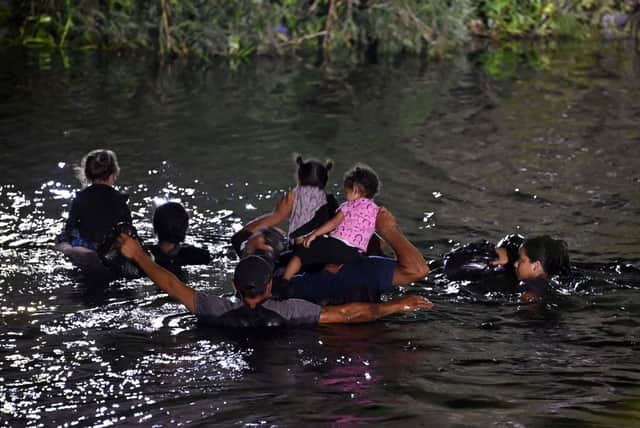What is Title 42? US Covid-19 asylum seeker policy expires - new immigration rules explained
and live on Freeview channel 276
Title 42 is a public health order that enabled the United States to halt entries into the country during the pandemic in order to stop the spread of Covid-19.
It was implemented by Donald Trump’s administration in March 2020, and allowed officials to turn away asylum seekers who came to the US-Mexico border on the grounds of disease prevention. The authority has been used to deport migrants - either to Mexico or their country of origin - more than 2 million times since its introduction.
Advertisement
Hide AdAdvertisement
Hide AdHowever, Title 42 expired at midnight eastern time (5am in the UK) on Friday 12 May. As Covid-19 is no longer a global health emergency, there is no longer an arguable need for the restriction.
A new immigration policy is now coming into force - and there are fears that it will make it even more difficult to claim asylum in the US, which has come as a surprise to many who considered Title 42 to be a harsh restriction. This has prompted migrants to race to enter the country before things change, with officials reporting that the number of people crossing the border has surpassed 10,000 a day.
President Joe Biden has warned the situation will be “chaotic for a while”. But what even was Title 42, what is changing, and what does it all mean for asylum seekers trying to enter the US?


What is Title 42?
Title 42 is a public health order that the US Centers for Disease Control and Prevention issued during the early days of the pandemic, with the aim of stopping the spread of Covid-19. The policy is widely known as Title 42, as ‘42’ refers to the section of US code that allowed officials to implement the order.
Advertisement
Hide AdAdvertisement
Hide AdBefore Title 42, asylum seekers could cross into the country, ask for asylum, and be allowed into the US to be screened and have their case considered. But Title 42 meant that authorities could cite public health concerns to both deny asylum to those arriving at borders and swiftly expel migrants who had crossed into the country.
The policy was implemented by Trump, and the Biden administration continued to use it amid legal battles and criticism from all ends of the political spectrum. Those on the left argued that Title 42 undermined the rights of asylum seekers and in continuing with it, Biden had broken campaign promises about creating a fair and humane system.


They also claimed that, while families and children travelling alone are supposed to be exempt from the rule, there have been variations in who the law is applied to and how it is enforced - resulting in widespread confusion.
Meanwhile, those on the right have argued the rule is not strict enough - pointing to the fact that there were no consequences when someone illegally crossed the border. This meant migrants who had been expelled were able to try again to enter the US, which they claimed could lead to a migrant “invasion”.
What are the new rules?
Advertisement
Hide AdAdvertisement
Hide AdA series of new policies have been put into place to crack down on illegal border crossings. Now, migrants who arrive at the border will not be allowed entry if they did not first:
- seek asylum in a country they travelled through
- apply online
Meanwhile, those who cross the border ‘illegally’ will be denied re-entry for five years. Those who try will face criminal prosecution.
There are some variations to the immigration policy - with families who arrive in the US not deported but subject to strict rules. The head of the household will have to wear an ankle monitoring bracelet, and all members will be subject to a curfew which runs between 11pm and 5am.
Officials will try to determine within 30 days whether a family will be deported or allowed to stay in the US - a process which usually takes years.
Advertisement
Hide AdAdvertisement
Hide AdThe US has also said it will accept up to 30,000 migrants per month from Venezuela, Haiti, Nicaragua, and Cuba, as long as they come by air, have a sponsor, and apply online first. 100,000 people will also be allowed in from Guatemala, El Salvador, and Honduras, provided they have family in the country and have also applied online.
What has the reaction been?
Many have welcomed the end to Title 42, with advocates for asylum seekers saying many of those who were expelled under the rule have faced dangerous and dire situations. Since Biden took office, Human Rights First says it has identified more than 13,000 incidents of kidnapping, torture, rape, or other violent attacks on people blocked or expelled to Mexico under Title 42.
But human rights groups have pointed to flaws in the new rules - saying it is wrong to assume safety for migrants in countries outside the US. They have also pointed to the inefficiency of the online application system, and warned that only a few will be accepted this way.
Meanwhile, the transition period is causing chaos on the border with Mexico, with panicked asylum seekers rushing to enter the US before the new rules come into force. There is also concern that, during this time of confusion, smugglers will spread misinformation and exploit vulnerable migrants for financial gain.
Comment Guidelines
National World encourages reader discussion on our stories. User feedback, insights and back-and-forth exchanges add a rich layer of context to reporting. Please review our Community Guidelines before commenting.
